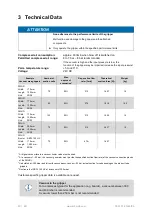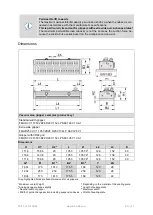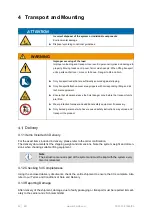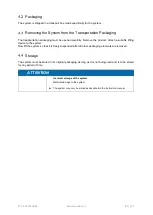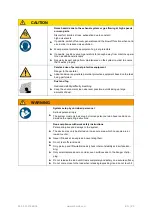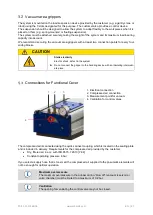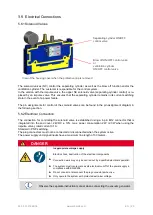
14 | EN
www.schmalz.com
30.30.01.01648/06
1.3 Multi-Pole Plug for Connecting the Control Cable
The int
egrated solenoid valves for the “Cylinder ON/OFF” and “Blow off ON/OFF” functions are con-
nected to the control via the connection plug (M12).
Version with ventilation cylinder:
The ventilation cylinder is activated instead of the “Blow off” function.
1.4 Protective Cap/Solenoid Valves
The protective cap must not be removed. The solenoid valves could be destroyed by moisture and dirt.
In the standard version and when using an ejector, two NC solenoid valves are used (24V DC). Their
power consumption is
1 watt. They control the separating cylinders and the “Blow off” function.
In the version with the impulse valve, the NC valve that controls the separating cylinder is replaced by
an impulse valve. In the event of a power failure, the cylinder remains in its current position. The impulse
valve has a power consumption of 1.3 watts (24V DC).
1.5 Compressed Air Connection for the Separating Cylinder
This connection is connected to the separating cylinder. If compressed air is applied, the cylinder ex-
tends a
nd closes the “Suction OFF” reservoir chamber.
1.6 Bore Hole for Vacuum Measurement
Connections A and B are connected to the bore holes 1.6 on both sides. (Connection B since May 2022
– see the information under 1.1)
1.7 Ventilation Cylinder Connection
In the standard version, this connection is closed with a plug that must not be removed. When using a
ventilation cylinder, this cylinder is connected here.
1.8 “Blow off” Connection
This connection is not closed in the standard version. The compressed
air flows out here when the “Blow
off ON” function is activated.
When using a ventilation cylinder, the connection is closed with a plug; this plug must not be removed.
B Separating Cylinder Assembly Unit
The separating cylinder assembly unit is attached to the base section of the gripper via a mounting plate
(2.1) and four screws (2.2). The separating cylinder (2.3) that is mounted on the base plate connects
and separates the reservoir chambers and valve chambers to and from one another. The separating
cylinder is single-acting and is pneumatically operated. This unit can be easily removed from the gripper
in order to check the seals or the contamination level of the gripper.




















